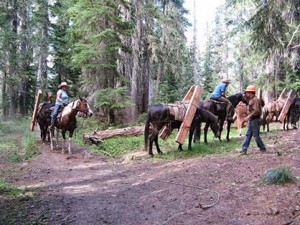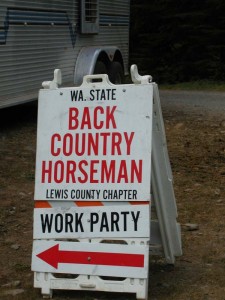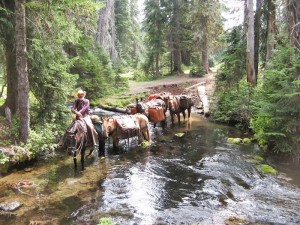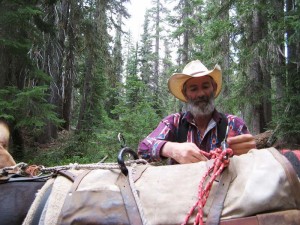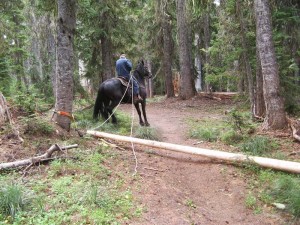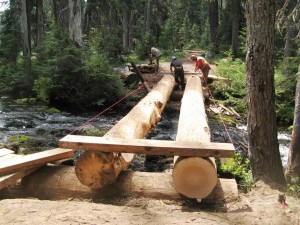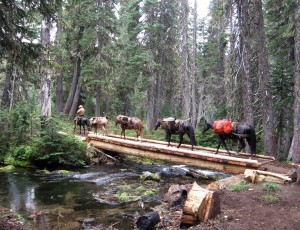Check Out What True Horsepower Can Do!
By: Sarah Wynne Jackson
Back Country Horsemen of America protects our right to ride horses on public lands, maintains countless miles of trails for all users, and completes improvements that just aren’t getting done. They look for opportunities to build strong relationships with other user groups, so we can work together to keep trails open for everyone. The bridge project on the Pacific Crest Trail at the Upper Bumping River is one good example.
A Call to Action
Several years ago, the bridge washed out where the Pacific Crest Trail crosses the Upper Bumping River at Goodwin Meadows in the William O. Douglas Wilderness in Washington State. Hikers used a foot log while equestrians were forced to navigate a river that could be deep and difficult at times.
Bernie Stratton, Director of the Lewis County Chapter of Back Country Horsemen of Washington, rides that area often and approached the US Forest Service Naches Ranger District about replacing the old bridge. The district sent out a trail manager to look at the project, then applied for a grant, and acquired partial funding.
The Original Horsepower
Once again, horses proved invaluable for working in a wilderness where motorized and mechanized equipment are prohibited, including carts, wagons, chainsaws, wheeled vehicles, and landing aircraft. All the decking, tools, material, spikes, rigging, and camp support for trail crews staying at the site had to be packed in by horses and mules, a trip of seven miles from the nearest trail head.
Pam Swigert and “Slim” Mardock, of the Lewis County Chapter, set up camp at the trailhead for a month to provide pack stock to haul in the cargo. The 4 inch x 10 inch x 6 inch cedar decking planks required 27 pack loads. Another 25 pack loads were needed to bring in the other cargo. In all, five and three-quarters tons of cargo and supplies were hauled to the volunteers’ Bumping River bankside camp.
Skilled Labor
Constructing the bridge took planning and expertise. Tom Mix and Del Sage of the Peninsula Chapter of BCHW headed up the rigging crew, who set up skyline rigging to place the bridge headers on the banks and the stringers across the river. The stringers for the 45-foot bridge span were cut from nearby spruce trees; 34-inch diameter logs that were peeled before being set in place.
The Earth Corps workforce placed the decking and built the approaches to the bridge. After completion of the project, Back Country Horsemen of Washington’s horses and mules hauled another 20 pack loads of tools and cargo back to the trailhead.
Appreciated Efforts
In today’s times of limited budgets and busy schedules, this project demonstrates that cooperation from a variety of trail advocacy groups gets wilderness projects done. Pacific Crest Trail through-hikers stopped at the construction site and thanked the crews for their volunteer efforts. Several hikers mentioned this was the most significant undertaking of infrastructure improvement they had seen during their entire hike.
Back Country Horsemen of America thanks Backcountry Horsemen of Washington and all the groups and individuals who worked on the various aspects of this project to make the new bridge a reality.
Back Country Horsemen of America commends the Naches Ranger District for doing a great job of organizing a coalition of trail user groups and volunteers to take on the project. The US Forest Service provided their technical experts Jeff Leisy and Kurt Langlois, Earth Corps working with the Pacific Crest Trail Association supplied much of the labor, Cascadia and the Washington Trails Association contributed to the labor pool, and BCHW lent pack support for the entire project. The BCHA Education Foundation awarded a $1,000 grant to purchase the bridge decking.
About Back Country Horsemen of America
BCHA is a non-profit corporation made up of state organizations, affiliates, and at-large members. Their efforts have brought about positive changes regarding the use of horses and stock in wilderness and public lands.
If you want to know more about Back Country Horsemen of America or become a member, visit their website: www.backcountryhorse.com; call 888-893-5161; or write PO Box 1367, Graham, WA 98338-1367. The future of horse use on public lands is in our hands!










